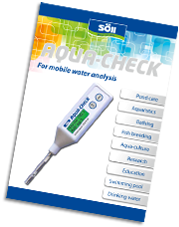If you look at the world‘s waters, where fish of all kind live, the specific water values are just as numerous as the fish living in them.
We want to present you the scope of some parameters which can be measured with AQUA-CHECK and AQUA-CHECK 2, and show you their specific meanings.
To make the subject of water values in aquariums a little more simple, we show you the scope of some parameters and their possible risks.
In the cited ranges, an appropriate keeping is usually possible (which does not mean that aberant conditions in the specific pool must be caused by wrong keeping etc.).
• pH-Value
• Nitrite
• Nitrate
• Ammonium
• Phosphate
• Copper
• Chlorine
• Carbonate hardness
• Total hardness
• Iron
• Fluoride
• Oxygen
Meaning of the pH-value
| pH-Value | Meaning |
| lower than 6,0 |
dangerously low (aberances for the keeping of different kinds of fish possible) |
| 6,5 - 7,5 |
low (aberances for the keeping of different kinds of fish possible) |
| 7,5 - 8,5 | Acceptable (aberances for the keeping of different kinds of fish possible) no need to react |
| higher than 8,5 | high (aberances for the keeping of different kinds of fish possible) Risks: Toxity of ammonia rises (creation of ammoniac) Recommendation: sink the pH-Value and stabilize the chalk-carbon dioxide balance (buffering system |
Meaning of the nitrite-value
| Nitrite-value | Meaning |
| Up to 0,1mg/L |
Acceptable |
| 0,1mg/L - 0,3mg/L |
High |
| Higher than 0,3mg/L | Very high Risks: Increased fish-toxicity and direct harm to organs Recommendation: Sink the amount of nitrite by exchanging the water with nitrite free water and treatment by microbiological products. Important: Regulation of the pH-value between 7.5 and 8.5 |
Meaning of the nitrate-value
| Nitrate-Value | Meaning |
| Up to 30mg/L |
Acceptable |
| Higher than 30mg/L |
High |
The meaning of the ammonium-value
| Ammonium-value | Meaning |
| Up to 0,5mg/L |
Acceptable |
| 0,5mg/L bis 1,5mg/L |
High |
| Higher than 1,5mg/L | Very high Risks: Increased toxicity and direct harm to organs Recommendation: Sink the amount of ammonia by exchanging your water with ammonia-free water and treatment with microbiological products or zeolite afterwards. Ammonia can be poisonous to fishes. Important: fixing the pH-value between 7.5 and 8.5 |
Meaning of the phosphate-value
| Phosphate-value | Meaning |
| Up to 0,035 mg/L |
Acceptable |
| Higher than 0,035 mg/L |
High |
Meaning of the copper-value
| Copper-value | Meaning |
| Up to 0,1mg/L |
Acceptable |
| 0,1mg/L - 0,14mg/L |
Acceptable |
| 0,14mg/L - 2,0mg/L | Harmful to fish, depending on kind. Recommendation: Decrease through copper binding products |
| Higher than 2mg/L | High Risiko: Toxicity Recommendation: Decreasing through copper binding products, possible water change |
Meaning of the chlorine-value
| Chlorine-value | Meaning |
| Up to 0,1mg/L |
Acceptable for usual water |
| 0,1mg/L - 0,3mg/L |
For usual waters: high For pools: too low |
| 0,3mg/L - 0,6mg/L | For usual waters: very high Harmful for flora and fauna. Starting fish toxicity (depending on kind). Recommendation: Binding of chlorine by special products For pools: acceptable Disinfecting effects at a pH-value between 6.5 and 7.6 |
| Higher than 0,6mg/L | Dangerously high Risks: Possible harm on every water user Recommendation: Binding of chlorine by special products. |
Meaning of carbonate hardness
| Carbonate hardness | Meaning |
| Lower than als 5°dH |
Too low |
| 5°dH - 14°dH |
Acceptable |
| Higher than 14°dH | High Risks: Coagulations (Carbonates) are possible Recommendation: Partial water change with water with low CH meaning of total hardness |
Meaning of total hardness
| Total hardness | Meaning |
| Lower than 8,4 °dH |
Soft water |
| 8,4°dH - 14 °dH |
Medium water |
| Higher than 14°dH | Hard water Risks: Coagulations (Carbonates, sulfates, phosphates, etc...) Recommendation: Technical softening of water change with soft water |
Meaning of the iron value
| Iron-value | Meaning |
| Lower than 0,2 mg/L |
Acceptable |
| High than 0,2 mg/L |
High: |
Meaning of the fluoride-value
| Fluoride-value | Meaning |
| Over 1,0 mg/L |
Acceptable |
Meaning of oxygen value
| Oxygen value | Meaning |
| 8 mg/L |
Acceptable |
| 4-8 mg/L |
Low |
| Lower than 4 mg/L | Extreme low Cumpulsory ventilation of the water or usage of oxygen giving products |







